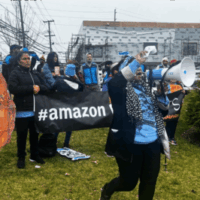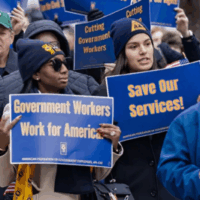This summer, our legal team has been very busy filing comments against US DOL’s worker attacks. After a relatively quiet 2018 at the United States Department of Labor’s Wage & Hour Division, in 2019 it proposed three anti-worker regulatory proposals in quick succession.
All three aim to roll back workers’ rights and open up more attacks on the worker livelihoods. These overt attacks will end many of the protections that had been in place before the Obama administration’s DOL. NELP and many allies filed comments opposing the proposals.
Here is a summary of the proposed roll-backs:
1. The Overtime Rule
On March 22, the Wage & Hour Division posted its rollback of the Obama-era Executive, Administrative and Professional (EAP) overtime rule. NELP’s comments trace the history of the Department’s actions on EAP overtime regulations, including the 2016 Obama Labor Department regulation that provided automatic overtime coverage to any worker making less than $47,476 per year, with automatic increases, projected to increase to $55,068 by 2022.
That regulation would have meant that about a third of the salaried workforce would receive the protections of overtime laws—a far cry from the more than 65 percent who were covered in the 1970s, but far better than the less than 7 percent presently covered.
The Trump Labor Department marched back from that regulation, proposing to guarantee overtime coverage only to those who make less than $35,308 a year. By the Department’s own analysis, that means that in year one, 2.8 million fewer workers will receive protection under the overtime laws, compared to what the Obama rule, and that number grows to 4.3 million by year ten.
We have just learned that the DOL’s final EAP overtime rule has been sent back to the White House’s OMB for final approval, a mere two months after the end of the public comment period, and in the midst of hundreds of thousands of filed comments. More to come on the final rule once it is published.
2. The Regular Rate Rule
On March 29th, the Wage and Hour Division proposed an employer-friendly revision to how a worker’s “regular rate” is calculated for purposes of overtime time-and-a-half pay. NELP’s comments opposed the provisions that categorically exempt certain payments employers make to employees, undercutting their overtime premium pay, in contravention of the purposes of the FLSA.
3. The Joint Employer Interpretation
And finally, April 1st brought a Fools’ Day proposed interpretation on the scope of the definition of “employer” under the FLSA. NELP submitted extensive comments that include the reasons why the proposal is contrary to the Act, including that it 1) ignores the definition of “employ” at 29 U.S.C. 203 (g), 2) picks only four common-law employment factors as relevant, and 3) would have devastating impacts on workers and law-abiding employers of a narrowed interpretation. NELP’s comments also summarized the data on the magnitude and characteristics of contracted work, to illustrate the kinds of jobs and impacts of the narrowed scope of covered employers.
As many know, for more than a century, the Fair Labor Standards Act has recognized the doctrine of ‘joint employer’ responsibility—the idea that two or more companies can share responsibility for the treatment of their workers. So when a company contracts out work to a staffing firm or other labor subcontractor, it may still share responsibility for the workers.
Joint employment ensures that the lead company using contractors provide better oversight of and compliance with minimum wage, child labor and overtime protections. Trump DOL’s guidance lets large corporations that outsource jobs off the hook, leaving typically smaller and poorly capitalized local businesses holding the bag for violations.
The DOL proposal would make it harder for workers to enforce wage and hour laws and will encourage more outsourcing to under-capitalized labor contractors like temp and staffing firms, especially in low-wage sectors such as construction, agriculture, garment, janitorial, home care, delivery and logistics, warehousing, and manufacturing.
Many, many allies filed very strong comments in opposition to this proposed interpretation, putting forth very compelling stories of workers and cases where joint employment was necessary to remedy the wage theft and child labor violations, showing the financial impacts of a weaker standard, and generally lodging opposition to the narrow proposal.
In the midst of these regulatory rollbacks, the Wage & Hour Division issued an April 29th Opinion Letter asserting that workers at a “virtual marketplace company” (what’s that!?) are likely not “employees” under the FLSA.
NELP issued a statement against the missive, saying that the Wage & Hour Division gave a “free pass” to the unnamed company to call its workers “independent contractors” via an overly-narrow reading of the scope of the FLSA.
NELP appreciates the wellspring of support and effort that many, many allies put into preparing and submitting comments on these worker attacks, and we stand ready to bring challenges to the rules once they are finalized. We hope you continue to join us in our Federal Fightback program. Trump’s DOL shows no signs of slowing down on its deregulatory agenda and we need more allies to join us.
Related to
The Latest News
All newsMayor Bowser & D.C. Council Must Respect the Will of D.C. Voters by Rejecting Repeal of Initiative 82

Blog
New Brief Sheds Light on the Amazon’s Dangerous ‘Flex’ Labor Model

News Release
NELP Denounces Supreme Court Ruling Permitting Immediate Layoffs of Hundreds of Thousands of Federal Workers

News Release
